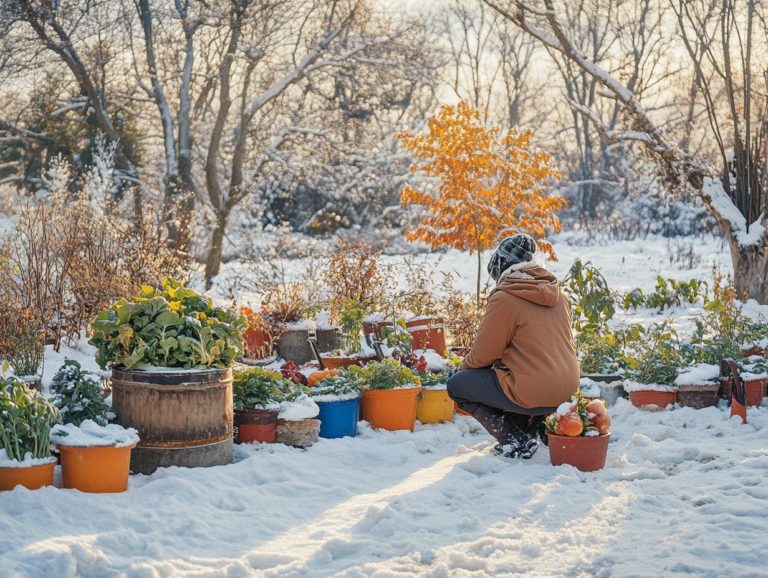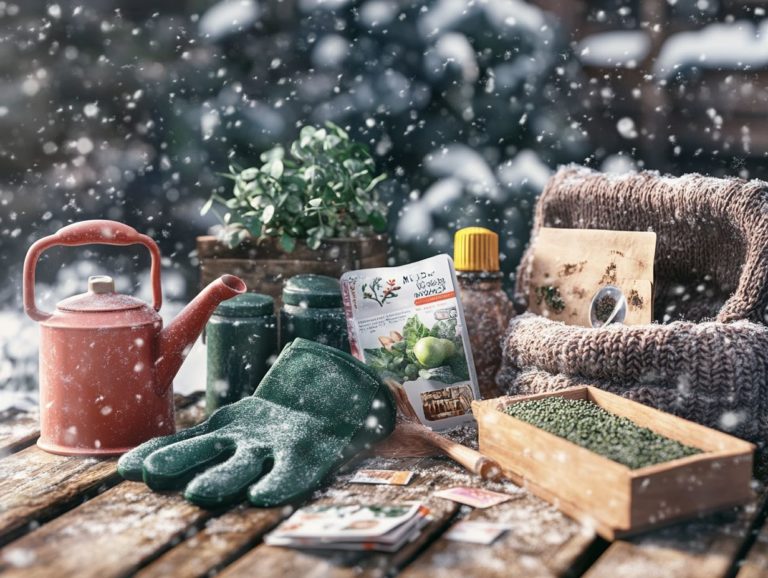Overcoming Winter Gardening Challenges
Winter gardening may seem intimidating, but with the right insights and preparation, it offers unique opportunities for growth.
Let s explore the challenges you might face, such as frost and limited sunlight, while offering essential tasks to prepare your garden for the colder months ahead.
Discover the best winter-friendly plants and learn effective techniques to protect them, along with strategies to tackle pests and diseases.
Get ready to make your garden flourish this winter!
Contents
- Key Takeaways:
- Understanding Winter Gardening Challenges
- Preparing Your Garden for Winter
- Choosing Winter-Friendly Plants
- Protecting Plants from Frost and Cold
- Maximizing Sunlight and Heat
- Dealing with Winter Pests and Diseases
- Frequently Asked Questions
- What are some common challenges that gardeners face during the winter?
- How can I protect my plants from freezing temperatures during the winter?
- What can I do to ensure my plants get enough sunlight during the winter?
- How do I prevent my soil from freezing in the winter?
- What types of plants are best for winter gardening?
- What are some tips for successfully growing plants indoors during the winter?
Key Takeaways:
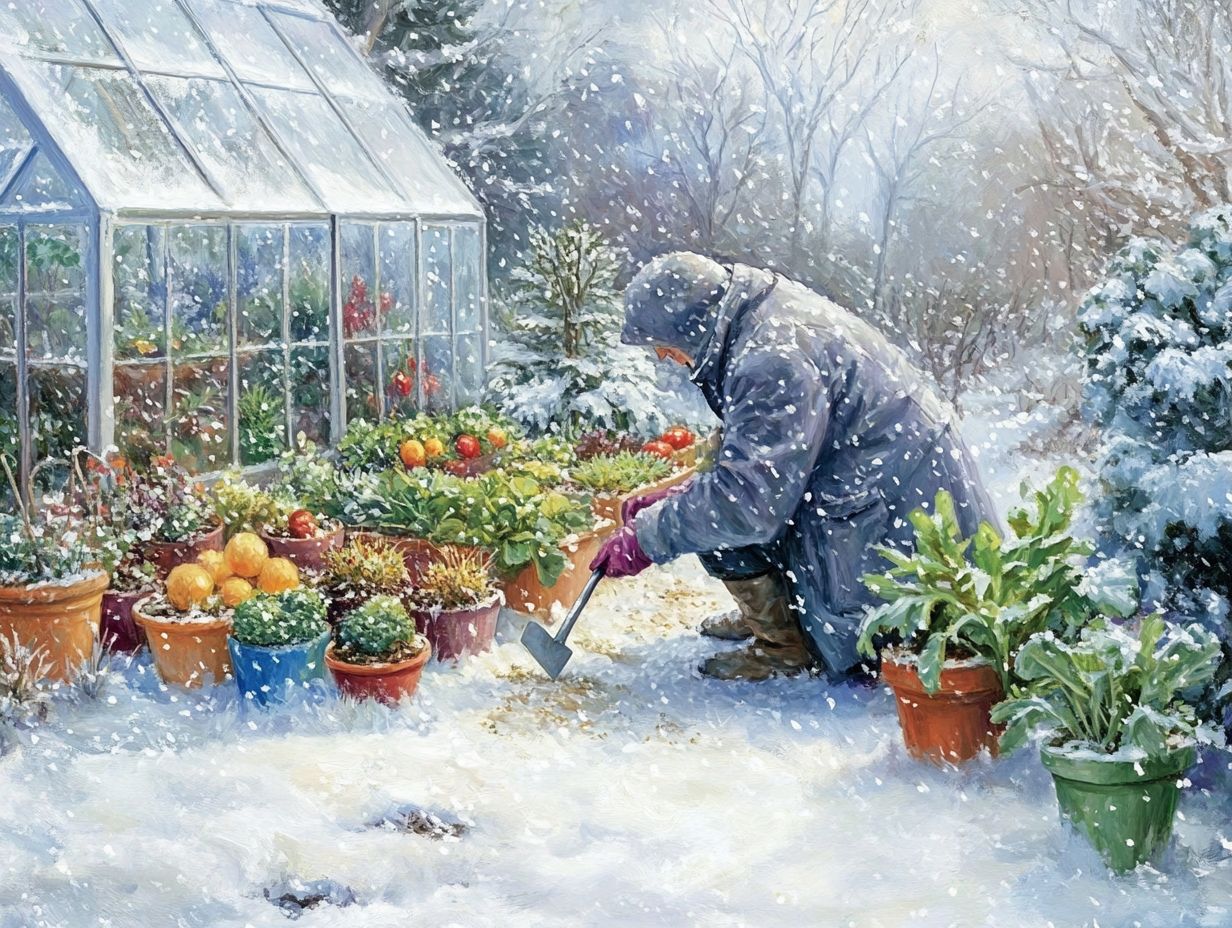
- Prepare your garden for winter by completing essential tasks and following helpful tips for organic gardening.
- Choose winter-friendly plants like carrots and kale that survive the cold and protect them from frost and harsh weather conditions.
- Maximize sunlight and heat for your winter garden by utilizing natural and artificial methods, including high tunnels and greenhouses.
Understanding Winter Gardening Challenges
Winter gardening has its challenges. Issues like cold weather and fluctuating temperatures can hinder plant growth in your hardiness zone, making it important to be aware of the top 5 challenges of winter gardening.
You may encounter problems like frost, which can freeze your delicate seedlings overnight, or limited sunlight that restricts photosynthesis during those shorter winter days. Additionally, the challenges of cold-climate gardening include pest problems that can complicate your efforts, as some pests remain active even in winter, threatening your plants and creating a need for effective organic gardening practices.
To tackle these challenges, consider employing season-extending techniques such as using cold frames, small structures that protect plants from cold weather, row covers, or hoop houses to shield your plants from frost. Additionally, using aquaponics for winter gardening can be an effective strategy to enhance your gardening efforts. You can also strategically position your containers to make the most of available sunlight.
Organic pest control methods like introducing beneficial insects or using insecticidal soaps can help you maintain a thriving garden ecosystem throughout the season, ensuring you can harvest food effectively.
Preparing Your Garden for Winter
Preparing your garden for winter involves a series of essential tasks that greatly enhance your winter gardening experience. Consider using protective structures such as cold frames, row covers, mini hoop houses, greenhouses, and Wall O Water.
These tools not only safeguard your plants from the harsh elements but also create favorable microclimates that can extend your growing season. With these methods, you can enjoy fresh crops all winter long!
Essential Tasks and Tips
When you embark on winter gardening, focusing on essential tasks and tips such as careful plant selection and precise crop timing is crucial for maximizing your harvest. For more information, check out the best practices for winter gardening.
Pay close attention to soil preparation. It lays the groundwork for robust winter crops. Amending your soil with organic compost not only enriches nutrient levels but also enhances its structure. This allows for better water retention during those chilly months, vital for growing healthy plants.
Mulching is a powerful tool you shouldn t overlook! A thick layer of organic material acts as an insulating blanket for your soil, conserving warmth and moisture while keeping pesky weeds at bay, especially during cold weather.
Timing your plantings is equally important. Consider sowing hardy varieties like kale and garlic in early fall to give them a strong start. Whether you re a novice or a seasoned gardener, these actionable tips will help you cultivate sustainable practices while nurturing a thriving winter garden.
By ensuring you reap a significant harvest, you’ll enjoy the fruits of your labor.
Choosing Winter-Friendly Plants
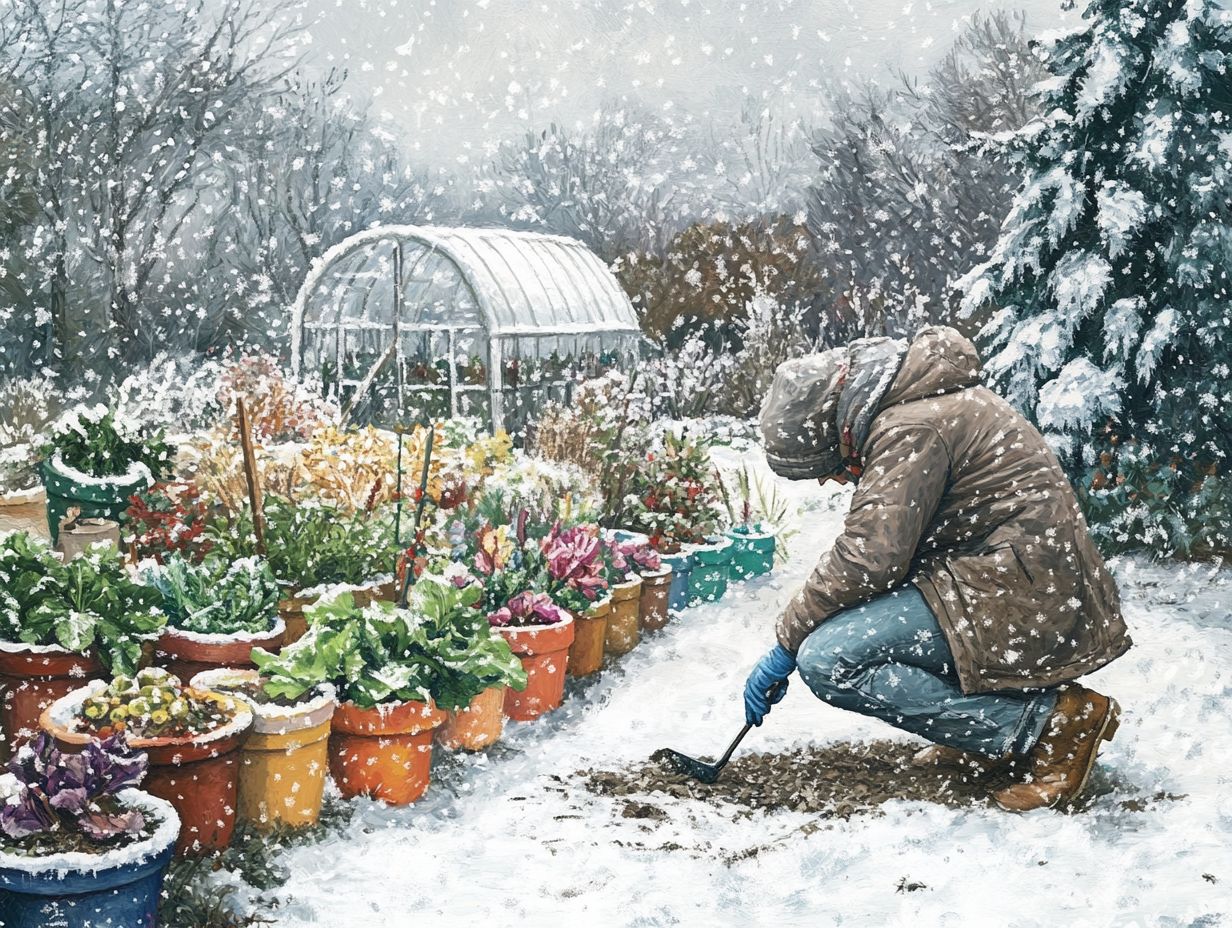
Selecting winter-friendly plants is essential for cultivating a thriving winter garden. Some vegetables flourish even in the chill, letting you savor fresh produce like carrots, kale, spinach, and broccoli, as well as herbs like parsley and cilantro throughout the season.
Herbs like parsley and cilantro, along with leafy greens such as lettuce and Bok Choy, can be grown successfully during winter months. This diversity contributes to a rich and varied harvest.
Best Plants for Winter Gardening
The best plants for your winter gardening endeavors include an array of vegetables and herbs that thrive in cold climates think carrots, kale, spinach, broccoli, parsley, cilantro, lettuce, and Bok Choy. All of these contribute to a nutritious fresh produce selection.
These resilient options endure lower temperatures while delivering a rich bounty of nutrients, vital for maintaining your health during the chillier months. They re great choices for organic gardening.
Take kale, for example; it s loaded with vitamins A, C, and K, making it a nutritional powerhouse that remains vibrant even when kissed by frost.
Utilizing techniques like raised beds, cold frames simple structures that protect plants from frost and high tunnels can significantly boost germination rates and support healthy growth. Coupled with regular maintenance, like mulching and proper watering, you ll enable these plants to reach their fullest potential.
These strategies help you enjoy a continuous harvest throughout the season, beautifully enriching both your pantry and palate while promoting fresh produce in your meals.
Protecting Plants from Frost and Cold
Protecting your plants from frost and cold is essential in winter gardening. Various methods, such as using cold frames, cloches, row covers, and mini hoop houses, can greatly enhance your plants’ resilience against harsh winter conditions. This ensures a successful harvest.
By implementing these protective techniques, you can ensure that your crops withstand the chill and continue to flourish throughout the winter months.
Effective Techniques and Strategies
Implementing effective techniques and strategies to protect your plants from frost and cold is essential for achieving success in winter gardening.
To ensure your garden thrives during the colder months, it s vital to adopt different techniques tailored to your specific plants and local climate. Consider using mulch as a protective blanket; it helps insulate roots against frigid temperatures.
Strategically placed windbreaks can shield your delicate flora from harsh winter winds, further minimizing frost damage, essential for organic gardening.
Regularly checking soil moisture and adjusting your watering practices is crucial since many plants require different care during dormancy.
Covering vulnerable species with cloth or using cloches provides an extra layer of protection. This keeps your garden vibrant and healthy even as winter unfolds, allowing for a better harvest.
Start your winter garden today for a bountiful harvest this season!
Maximizing Sunlight and Heat
Maximizing sunlight and heat during the winter months is key to thriving this winter! You can employ both natural and artificial methods to create a warmer environment for your crops, facilitating optimal crop timing.
Consider orienting your garden to capture the sun s rays effectively. Using heat-retaining materials helps ensure your plants receive the light and warmth they need. These techniques promote healthy growth and are important for a fruitful harvest.
Utilizing Natural and Artificial Methods
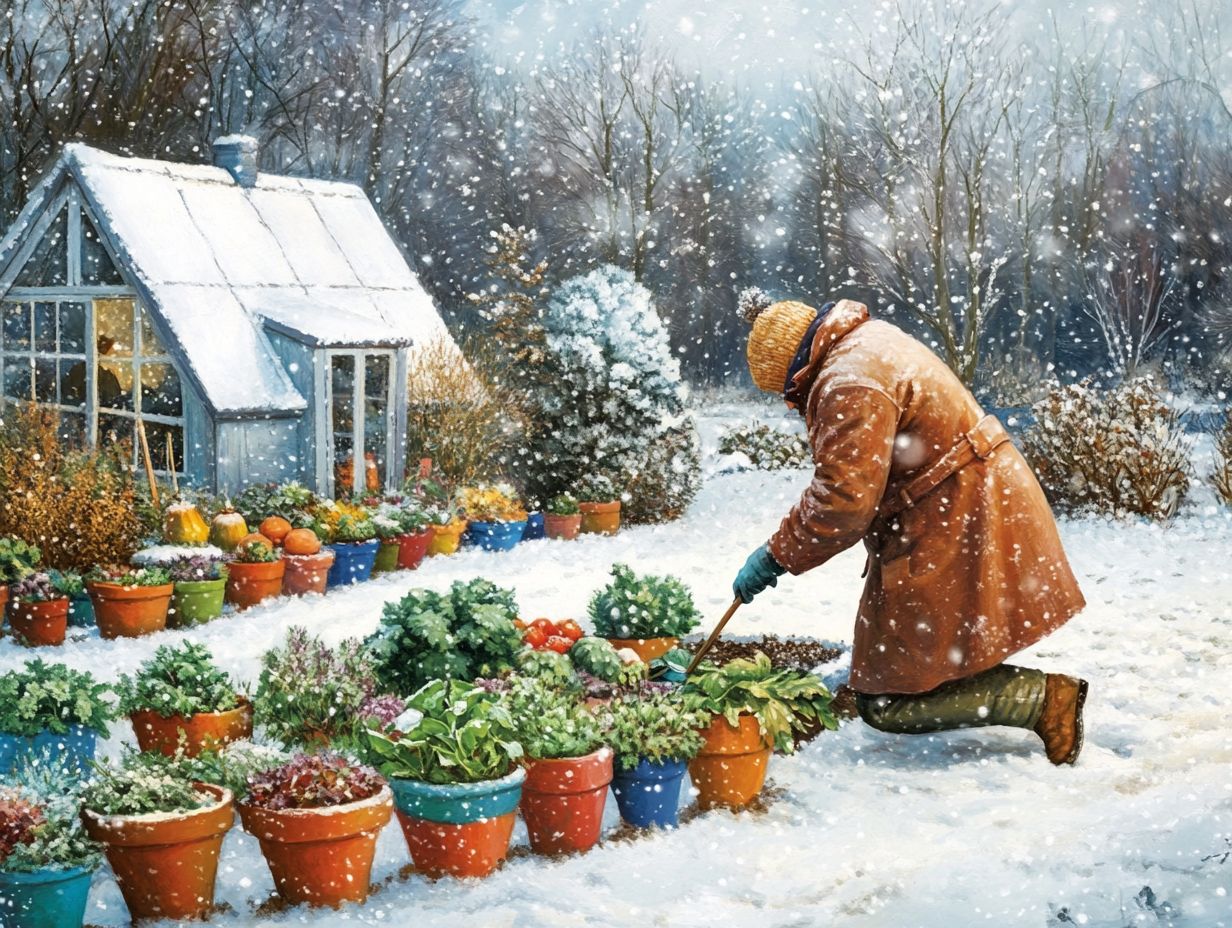
Utilizing both natural and artificial methods to maximize sunlight and heat can significantly elevate your winter gardening endeavors, especially when considering organic gardening techniques.
Strategically position your crops in areas that capture optimal sunlight to effectively harness nature s warmth. Adding heat mats beneath your seedlings creates a controlled environment, promoting vigorous growth even in cooler temperatures.
This improves your chances for a successful harvest. Incorporating reflective surfaces, like Mylar or light-colored materials, enhances light distribution by bouncing sunlight back to your plants, ensuring they receive the illumination crucial for maintaining plant health.
Each of these techniques is essential for maintaining plant health and boosting productivity. By utilizing vertical gardening in winter, you can cultivate a flourishing winter garden that can yield a significant harvest despite the challenges of the season.
Dealing with Winter Pests and Diseases
Managing winter pests and diseases is vital for successful winter gardening. Even in the chill of winter, certain pests can still be active, and diseases can rear their heads, impacting your potential for a fruitful harvest. For valuable insights, check out these winter gardening tips for enthusiasts.
Implement effective prevention and treatment strategies to protect your crops and secure a bountiful harvest, which is vital for any winter gardening enthusiast looking for tips for growing microgreens in winter.
Prevention and Treatment Measures
Implementing robust prevention and treatment measures against winter pests and diseases is essential for maintaining plant health throughout the winter gardening season. This ensures you can enjoy a diverse range of fresh produce.
Adopt a proactive approach to significantly reduce the chances of pest problems and infections. Start by meticulously cleaning your planting areas to remove debris that could harbor pests and pathogens.
Consider incorporating companion planting planting certain plants together to help each other grow with natural pest-repellent herbs to create a strategic defense. This enhances your efforts for organic gardening success.
Utilizing organic mulches is a win-win; they retain soil moisture and act as a barrier against unwanted insects. Regular monitoring and introducing beneficial insects, like ladybugs, will further enhance biological control.
Frequently Asked Questions
What are some common challenges that gardeners face during the winter?
Some common challenges that gardeners face during the winter include cold temperatures, lack of sunlight, and freezing soil. To address these issues, you can explore winter gardening challenges and how to overcome them.
How can I protect my plants from freezing temperatures during the winter?
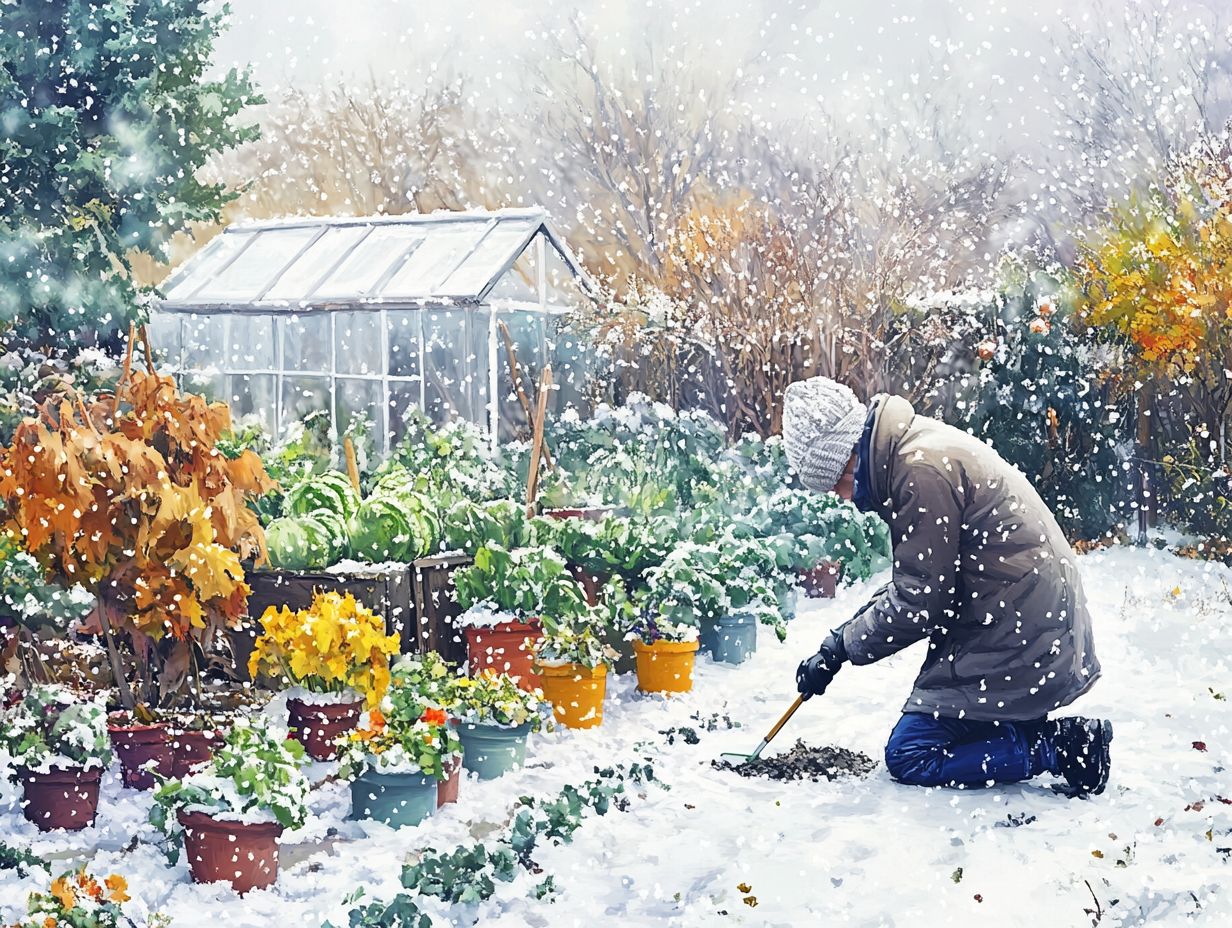
To protect your plants from freezing temperatures, cover them with frost blankets or cloths, use mulch to insulate the soil, and bring potted plants indoors.
What can I do to ensure my plants get enough sunlight during the winter?
One way to ensure your plants get enough sunlight during the winter is to place them in a south-facing window or use grow lights to supplement natural light.
How do I prevent my soil from freezing in the winter?
You can prevent your soil from freezing by adding a layer of mulch to insulate the soil. Use raised beds to keep the soil warmer, and avoid compacting the soil, which can lead to faster freezing.
Start your winter gardening today for a bold harvest tomorrow!
What types of plants are best for winter gardening?
Winter gardening thrives with cold-tolerant plants. Favorites include kale, spinach, and Brussels sprouts, all of which can handle freezing temperatures.
What are some tips for successfully growing plants indoors during the winter?
Grow plants indoors by giving them plenty of sunlight or using artificial lights. Keep the air humid and be careful not to overwater.

